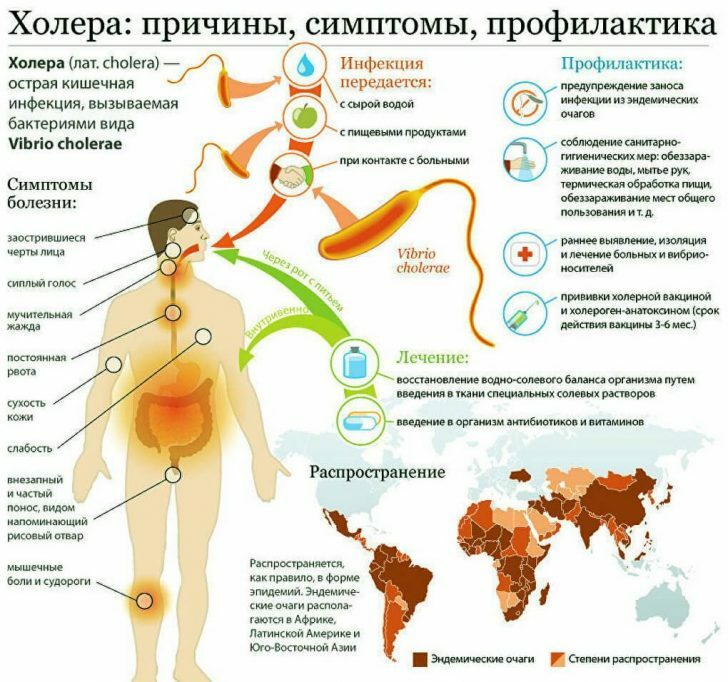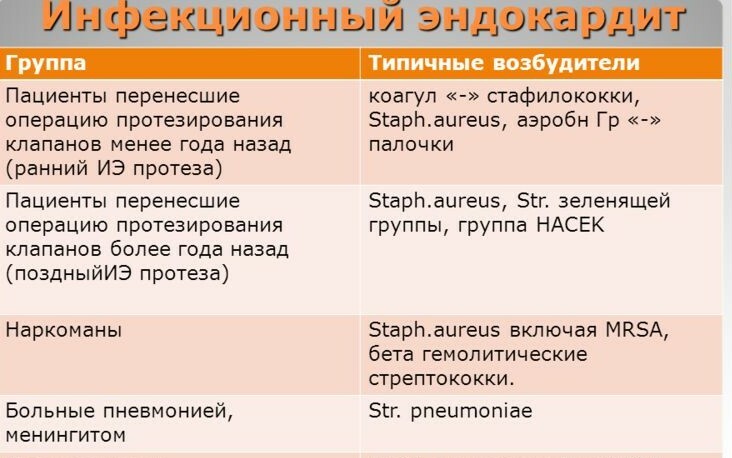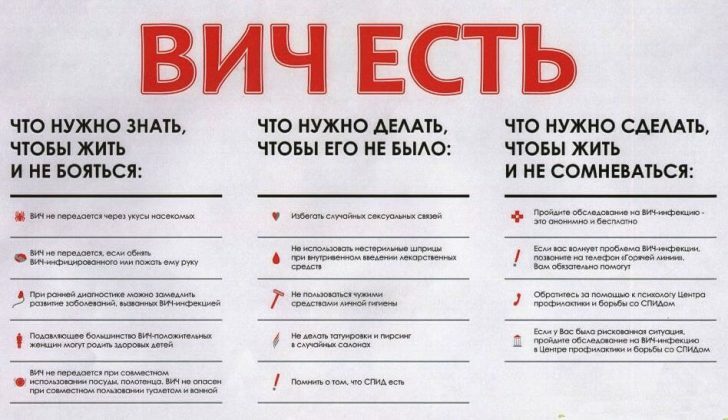Chickenpox in children: symptoms and treatment
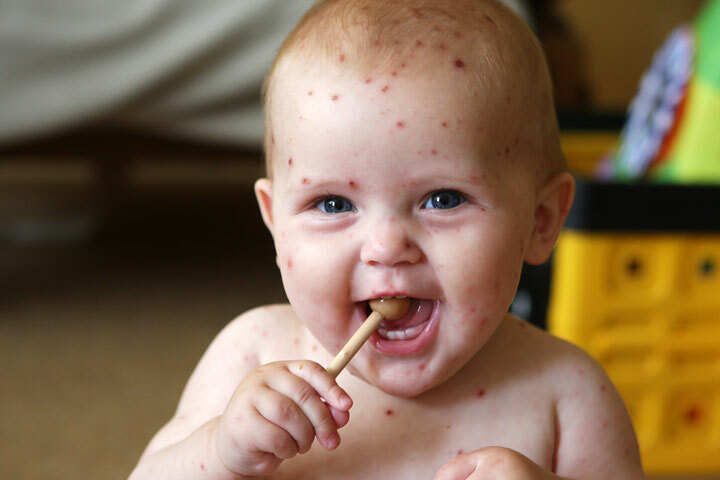 The term "chicken pox" means chicken pox.This infectious virus disease with a high level of infectiousness in children occurs in most cases in a fairly easy form.Severe course and complications are not excluded in infants, adult patients, as well as children with low levels of immunity.With adequate treatment, complications do not develop often.
The term "chicken pox" means chicken pox.This infectious virus disease with a high level of infectiousness in children occurs in most cases in a fairly easy form.Severe course and complications are not excluded in infants, adult patients, as well as children with low levels of immunity.With adequate treatment, complications do not develop often.
The causative agent of chicken pox refers to herpes zoster viruses.It is highly resistant to the environment.
As a rule, the virus is transmitted by airborne droplets.The infectious agent penetrates the body through the mucous membranes of the eyes and the upper respiratory tract.The contact route of infection with the virus is also not excluded.In the incubation period, the disease can be from 1 to 3 weeks( but not more than a week and not less than 21 days).Contagious for those who are ill, it ceases to be 7-10 days after the appearance of the first clinical signs of the disease.
Note: the patient can transmit the infection to others, even without knowing that he is sick.
The infectious period of the disease usually begins 1-2 days before the appearance on the baby's skin of a typical chickenpox rash.A sick child poses a danger to others, until the appearance of a new rash stops, and previously arisen will not dry up and will not be covered with a crust.
Table of contents: Symptoms of chickenpox Stings of chickenpox in children Possible complications of chickenpox in children Treatment of chickenpoxSymptoms of chickenpox
The first signs of chicken pox in children are usually indistinguishable from "normal" SARS.
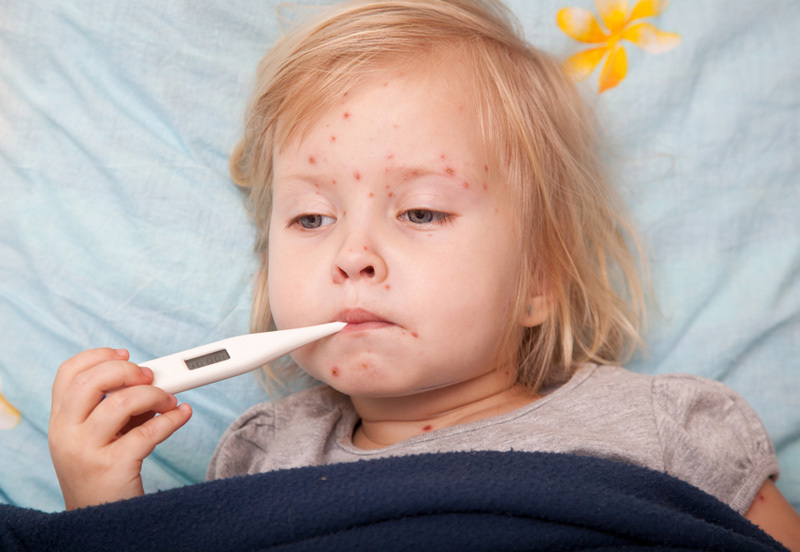 The child appears:
The child appears:
- high temperature( up to 39.5 ° C),
- febrile reaction;
- headache of medium intensity;
- pain in the abdominal area( not always);
- general malaise;
- signs of intoxication( nausea and vomiting possible);
The main symptom of chickenpox is a characteristic rash( first small pink spots, and then - bubbles with clear liquid).
The appearance of vesicles is accompanied by severe itching, which is very poorly tolerated by young children.The rash is localized mainly on the trunk, head( both the face, and the scalp), and also on the genitals and mucous membrane of the oral cavity.Bubbles are the most painful in the mouth.
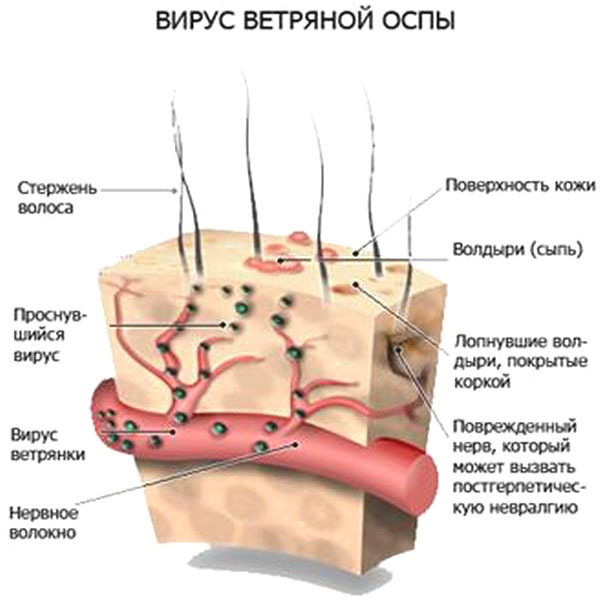
First, a round reddening of the skin is formed, and then a bubble with a clear liquid forms in its place.After a while they dry up, becoming the kind of crusts.Chickenpox can be characterized by a wavy course, so the characteristic skin rash in a child can appear several times during one disease.
Stages of rash with chickenpox in children
Eruptions on the body of a patient with chickenpox pass through several basic stages.
Stage I is characterized by the appearance of small itchy red dots that increase over time and when combed
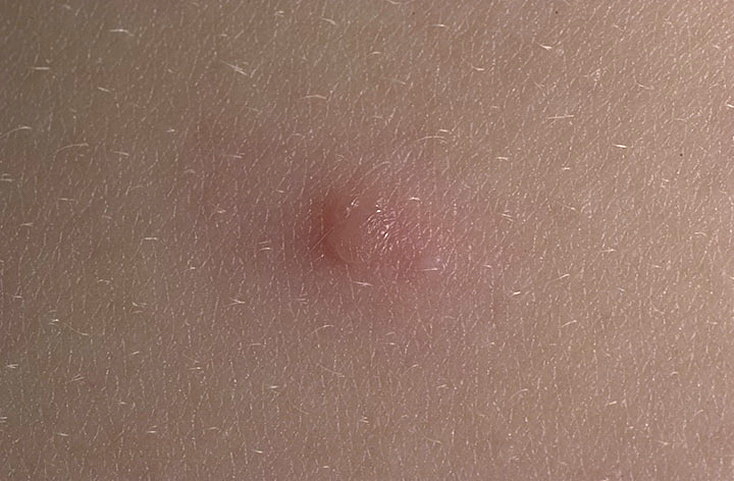
II stage - the appearance of bubbles filled with a transparent liquid
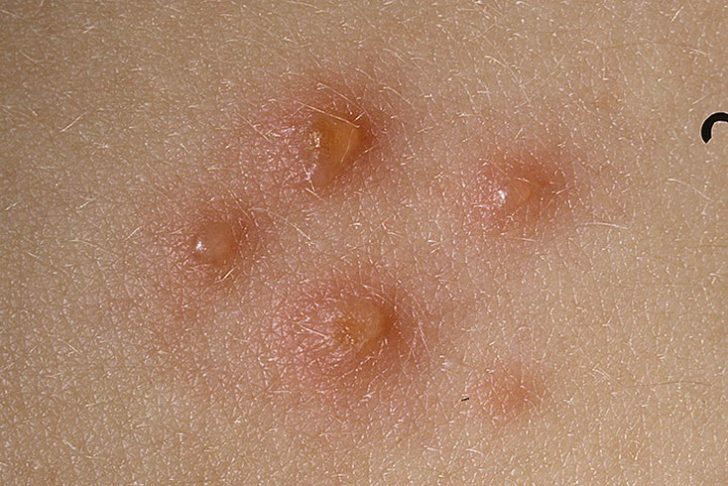
III stage - drying of bubbles
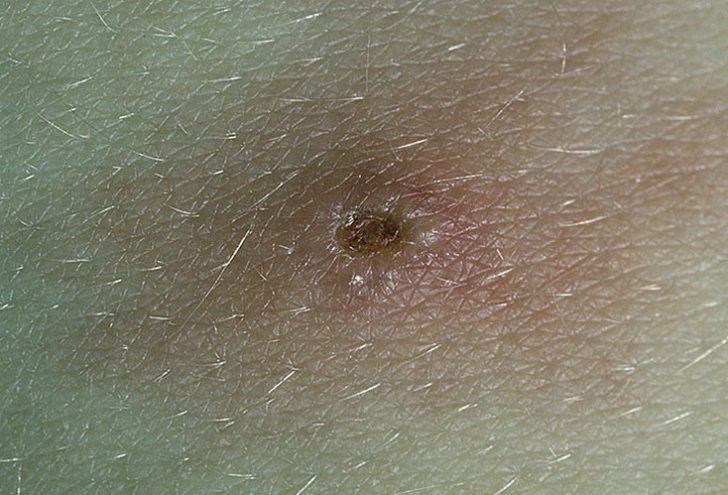
In some casesThe first stage can go directly to the third stage.In the midst of an illness on the body of a child, you can see a variety of eruptions.The skin of a sick with chickenpox looks like this:
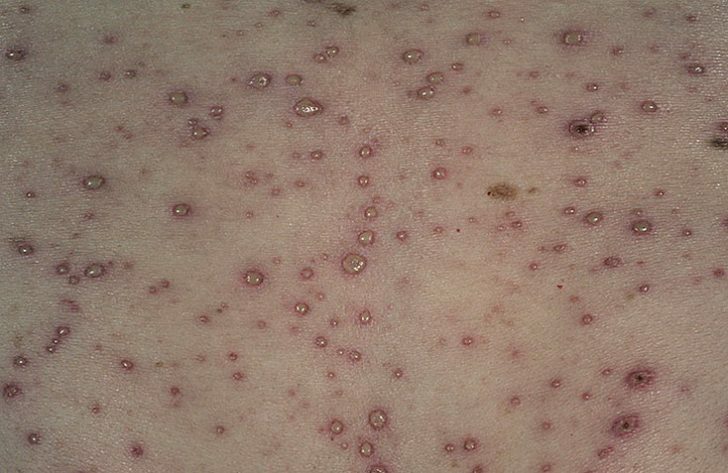
Possible complications of chickenpox in children
After the transferred chicken pox, stable immunity forms, so they usually get sick only once in their life.The probability of re-infection is very low.
With chicken pox, a virus enters the body, which in a number of cases can be activated again in adulthood.In this case, there is a rash, known as herpes zoster( also called "shingles").
On the skin of the child, marks may remain on the place of the elements of the rash, especially if they are ripped off with care.Traces are usually visible for quite a long time - from 6 months to 1 year.
The general weakening of the body against chicken pox in a number of cases leads to the development of dangerous bacterial infections( secondary).It is possible, in particular, such a complication of chicken pox, such as pneumonia and encephalitis.
Important : encephalitis is a fairly rare complication;It is manifested by such symptoms as confusion, hyperthermia and intense pains with irradiation in the hands and feet.
In case of clinical manifestations that allow suspected complications, the patient should immediately be hospitalized
Treatment of chickenpox
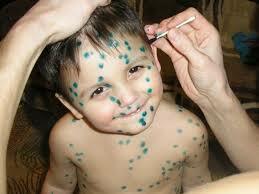 What if you suspect chickenpox from your child?The first thing is not to panic!Therapy consists in overcoming unpleasant symptoms.In any case, you should consult your doctor, who will make up the treatment tactics
What if you suspect chickenpox from your child?The first thing is not to panic!Therapy consists in overcoming unpleasant symptoms.In any case, you should consult your doctor, who will make up the treatment tactics
The mild form of chickenpox is usually treated out-patient.Calling a doctor is mandatory if the child's fever lasts longer than 4 days.The patient must be isolated in order to avoid the spread of infection.
Compliance with strict bed restraint is not a prerequisite, although mobile games are contraindicated for the child due to the general weakening of the body.
Note: for severe general condition( significant cutaneous manifestations and symptoms of nervous system damage) requires therapy in a hospital.
The medicinal treatment of chickenpox combines pathogenetic( antiviral drugs) and symptomatic therapy.It is important to avoid the attachment of a secondary bacterial infection.Excellent external antibacterial and drying drug is lotion "Kalamin".You can also use for the treatment of rashes usual solution of brilliant green, solution of fucocine or so-called.Solution Castellani.
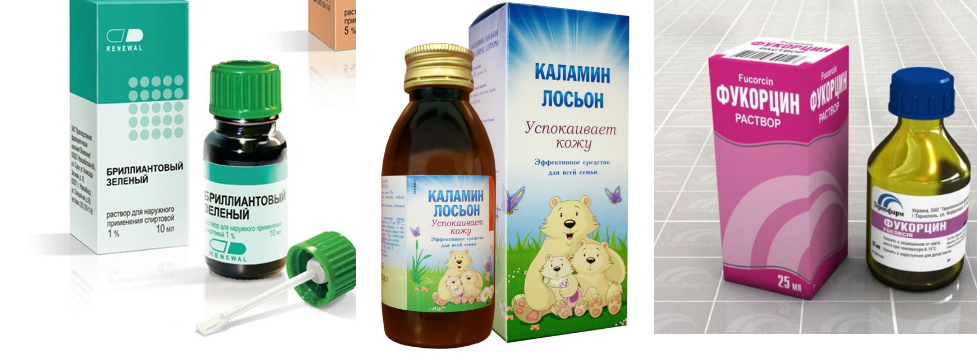
To remove toxins from the body as soon as possible, it is recommended to consume as much liquid as possible.To reduce the overall body temperature, the child is given ibuprofen or paracetamol( acetylsalicylic acid is not recommended).
To reduce the feeling of itching, the desensitizing agent Diazolin is recommended.
If necessary, the doctor may also prescribe the eye gel Acyclovir or rectal suppositories Viferon.
If the child has mucosal lesions of the oral cavity, then he should adhere to a sparing diet, avoiding salty foods, citrus and other products that irritate the oral cavity.
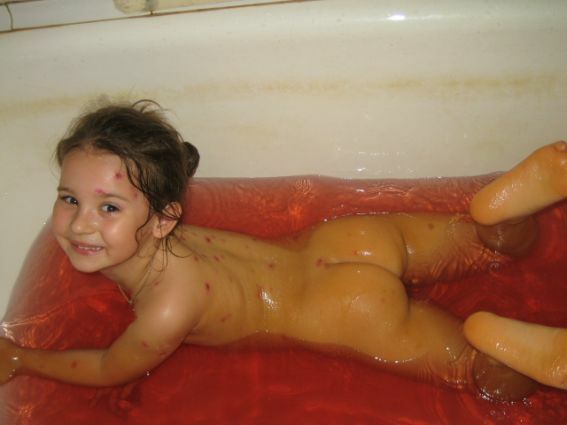 If the lesions are observed in areas of the body where the skin is especially tender( for example, on the genitals), and chickenpox is accompanied by itching or pain, it is recommended to use( topically, topically) pharmacological agents with analgesic effect.With an infection, baths with an antiseptic, for example - potassium permanganate( manganese), will help to cope.
If the lesions are observed in areas of the body where the skin is especially tender( for example, on the genitals), and chickenpox is accompanied by itching or pain, it is recommended to use( topically, topically) pharmacological agents with analgesic effect.With an infection, baths with an antiseptic, for example - potassium permanganate( manganese), will help to cope.
Walking in the fresh air can be done already at the onset of convalescence( recovery).When you can attend a school or kindergarten in this case, only the district pediatrician decides.
If an abscess forms on the site of the rash, this is an indication for the use of an antibacterial ointment.The addition of a secondary bacterial infection may require the initiation of antibiotic therapy.
Important: , a patient with chickenpox, ceases to be infectious only after self-separation of the last crusts.
Traditional medicine in the treatment of chickenpox
With chicken pox, treatment with folk remedies is possible.It is advisable to give the child fresh berries of blueberries or blueberry juice.The active substances of the fruits of this plant have antiviral properties.It is also recommended that children drink infusion from a mixture of lime flowers, raspberries, willow bark and anise fruits( brewed at the rate of 300 ml of water per 1 tablespoon of collection).
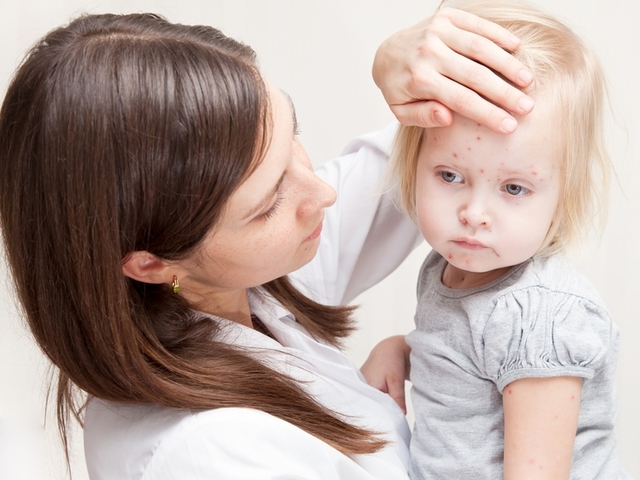 Honey with lemon juice or nuts has a general strengthening effect.
Honey with lemon juice or nuts has a general strengthening effect.
With a skin rash with chickenpox, bathing in chamomile broth( 60 grams of raw material per liter of water) will help you to cope faster.Inside, you can take( 1/3 cup four times a day) decoction of herbal collection, which includes the root of burdock, calendula flowers and chamomile, as well as the aerial parts of chicory and mother-and-stepmother.Twice a day after meals, it is indicated to use inside the broth from a mixture of calendula, lemon balm, basil and chamomile.
Treatment should be started as soon as possible( within 1-2 days after the appearance of the first, even single, rashes).
Chickenpox in infants
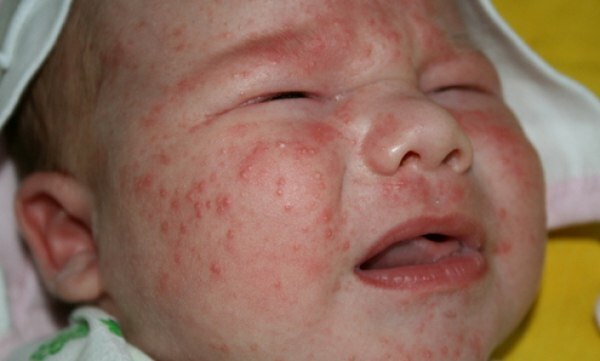
It should be remembered that any child from the age of six months can get chickenpox.In most cases, the course of the disease in infants is quite complex: such small children do not tolerate symptoms, can not complain and can not take advice.As a consequence, they need more care and constant attention from the mother.
Chickenpox in newborns is characterized by the same symptoms, but in young children, chickenpox, which occurs in a particularly complex form, can cause serious harm to the body, affecting the development of internal organs.Treatment of chicken pox in infants should be under the strict supervision of a qualified pediatrician.
We must try to ensure that the child does not rip off the crusts from the drying rashes, tk.This will only increase the itching and increase the risk of re-infection.The hands of the child need to be washed more often, since the virus can be present on the skin and under the fingernails.The nails should be short-cut.At night, it is recommended that the baby wear cotton gloves.
Prevention of chickenpox
A number of medications, as well as timely vaccination with Ocabax or Varilrix can prevent the infection of a person in contact with the patient if the vaccine is administered between 2 and 3 days from contact.Avoiding infection within the same family is almost impossible( the probability of infection is 90%).

Vaccinations against chicken pox are administered to children who reached the age of 6 months.
Children with low immunity, as well as those who have undergone bone marrow transplantation, are at particular risk.They should be protected in every possible way from infectious children and adults.
Otherwise, remember that you are sick with chickenpox just once in your life, and having chickenpox in childhood is much easier than transferring the disease to a more mature age.
For more information about treating chickenpox in children, we recommend that you review this video review: the pediatrician, Dr. Komarovsky, tells the story of the chickenpox:
Chumachenko Olga, pediatrician

